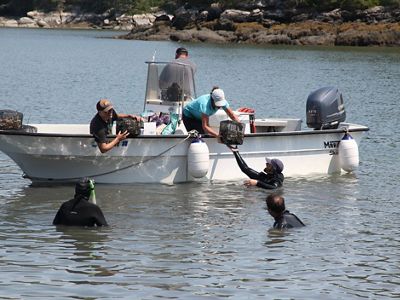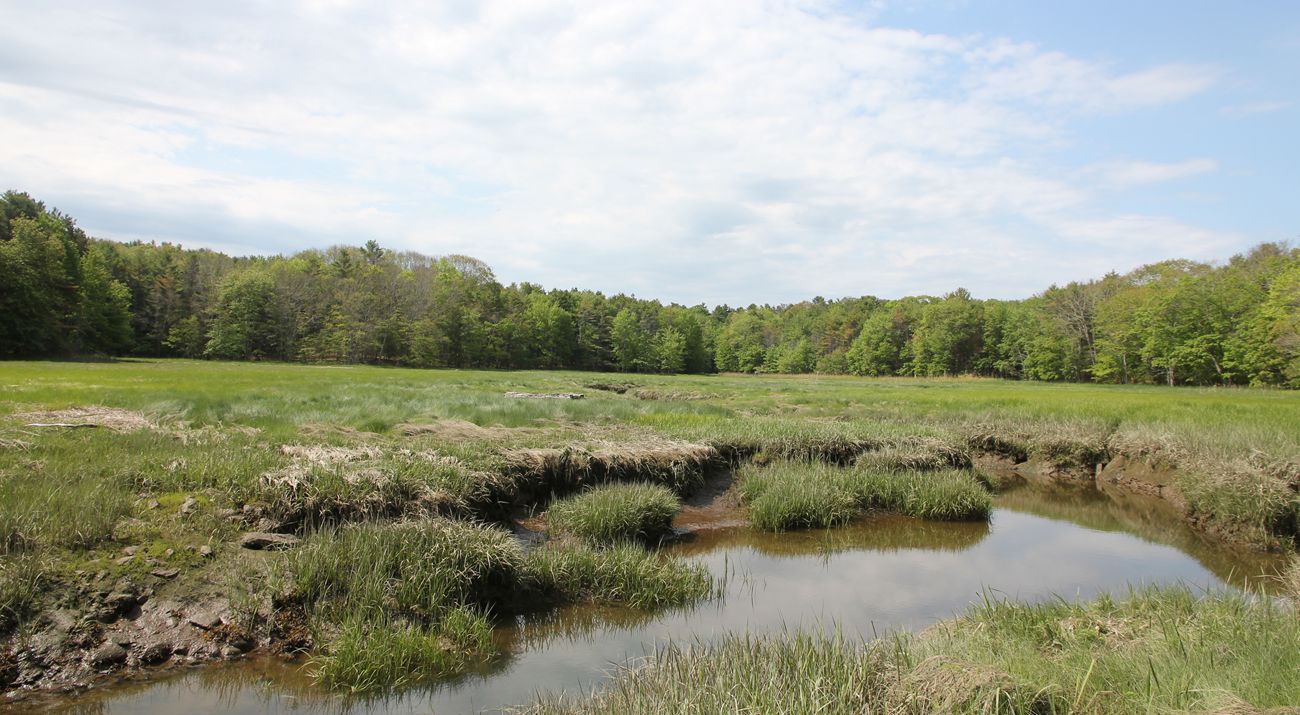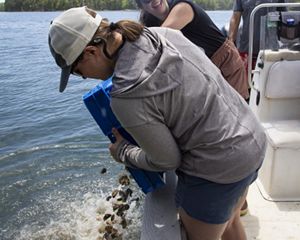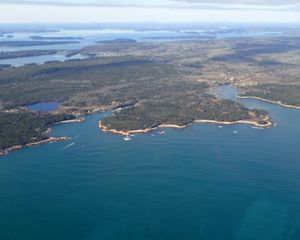How Maine’s Salt Marshes Can Save the Day
Making room for nature can help communities adapt to climate change.
On a bright spring day in 2015, Jeremy Bell stood in the center of a gravel road and scanned the tidal marsh that surrounded him. Sharp grasses rose in every direction, holding together clumps of semi-hardened mud laced with small meandering tidal channels and isolated pools. He listened as Nancy Sferra, The Nature Conservancy’s director of land management in Maine, described how she intended to restore the area.
The recently acquired Mill Pond Preserve had a single old house, some outbuildings, and this long gravel driveway that crossed the center of the marsh, spanning the main creek channel with a cribwork bridge made from giant timbers that had long ago settled into the muck. The old house and other structures had already been demolished and removed, and the bridge of timbers was going to go next.
At the time, Bell was TNC’s river and coastal restoration director and he quickly identified the impact that bridge had on the workings of the marsh. As the tide flowed in and out, the structure, and the low berm created by the road, trapped sediments behind them. He could see a clear difference between the side connected to the ocean and the side blocked for decades from the natural breathing of the tidal cycles. The marsh was stagnant, and its channels and pools were shallow and heavy with material unable to wash away.
Allowing Water to Move So Marshes Can Adapt to Climate Change
Today, maintaining that marsh’s connection to the sea is more critical than ever. The impacts of climate change are already being felt in Maine, and TNC is developing a number of strategies that take advantage of nature’s ability to make a real difference in how it affects all of us. Jeremy Bell now leads that work as TNC in Maine’s first climate adaptation program director.
Quote: Jeremy Bell
It’s about working with nature, not fighting against it.
Bell has already worked with partners to develop the Coastal Risk Explorer, a web-based tool that helps municipal planners along Maine’s coast understand how sea level rise will likely impact their communities. Another web-based tool he helped develop, in partnership with the Maine Natural Areas Program, is the Future Habitat Explorer, which uses geographic modeling to predict how tidal marshes like the one at Mill Pond will change and grow with rising seas. Armed with this information, communities and conservation organizations can make informed decisions about where to discourage development so the marshes have a place to go.
Why Are Tidal Marshes Important?
Salt marshes certainly play a critical role in the aquatic food web, but they can also protect cities and towns from coastal flooding by absorbing the influx of water during storm surges and providing buffers between the sea and homes and businesses. Even the effects of floodwaters from the land can be similarly reduced. And, these storm events are already happening with more frequency and intensity.
“It’s a good example of what we call a nature-based solution or NBS,” says Bell. “In addition to reducing carbon emissions, there are already climate impacts that we need to adapt to now. Nature-based solutions tap into the power of nature to limit the effects of climate change while preserving habitat and protecting people. It’s about working with nature, not fighting against it.”
Currently, Bell is working with the town of Woolwich, the Kennebec Estuary Land Trust, and the Maine Department of Transportation to restore the Back River Marsh by enlarging a bridge on Route 1 and removing a section of the adjacent George Wright Road. This road has direct exposure to ocean waves and impedes tidal flow to the marsh. At the same time, the water supply line for the City of Bath and power lines that feed energy to Arrowsic and Georgetown, which run through and along the road, will be secured by moving them out of the flood-prone area.
More Nature Based Solutions: Grasses, Dunes and Oyster Reefs
Other NBS examples include protecting sand dunes and eel grass beds along the coast. While rock or cement sea walls might keep the ocean out of a small area, that water is just deflected to come ashore somewhere else. Grasses and dunes can help absorb storm water, buffering the blows to the shore and reducing erosion and flooding to the land.

Oyster reefs also help break up storm surges while filtering water and providing food and economic sustainability. It’s important to note that eel grass beds and oysters thrive in different conditions, so a variety of solutions may be needed to suit different areas.
“The coast of Maine has many ecological and geological faces,” reflects Bell. “From the broad sand beaches in the south to the rocky shores Downeast and everything in between. It certainly demands more than a one-size-fits-all approach.”
Helping Communities Adapt to Sea-Level Rise
But what happens when the rising seas become too much? Innovative options are already being considered on both U.S. coasts. Some properties that frequently become flooded are now public parks. They are enjoyed for relaxation and recreation during dry times and provide a place for floodwaters to go that doesn’t destroy homes or businesses.
Another concept being considered on the West Coast involves towns offering to buy homes that are likely to be overwhelmed by rising seas and making up the property tax loss by turning them into AirBnBs until they are no longer safe.
“I’ve talked to a lot of town leaders and the biggest uncertainty they have is not so much what the climate impact will be, it’s how they’re going to respond to it,” says Bell.
To provide these leaders with as many options as possible, Bell is also talking with state and federal agencies to encourage inclusion of NBS in their work as well. And, there’s currently a bill going through the legislative process in Augusta that would require state agencies to account for sea level rise in their decision making.
“I’m hopeful,” concludes Bell. “If we all pull together in the same direction, we can adapt and make the world better for all those who follow. Doing nothing is not an option.”
Back at Mill Pond Preserve, now six years later, the gravel road is a vague shadow in the thickening grasses and the marsh is easing back into the cycles dictated by nature. This is a place where something was done—and the world is better for it.




